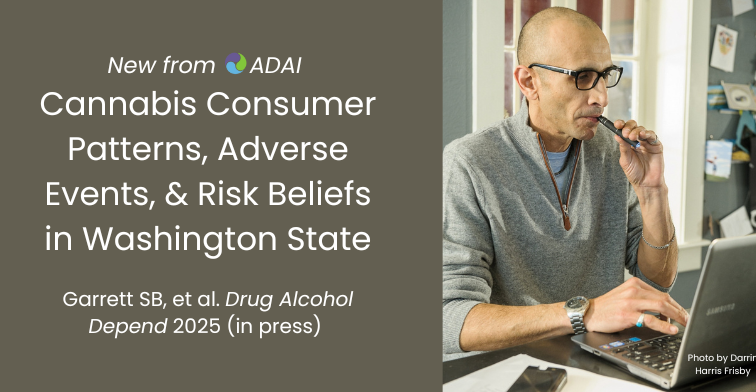New ADAI Publication: Cannabis Consumer Patterns, Adverse Events, and Risk Beliefs in WA State
05/29/2025Citation: Garrett SB, Williams J, Carlini BH, Hammond D. Cannabis consumer patterns, adverse events, and cannabis risk beliefs: A latent profile analysis in WA State. Drug and Alcohol Dependence 2025 (in press). doi: 10.1016/j.drugalcdep.2025.112728

Legalization of cannabis has led to an expansion in the types of cannabis products available to consumers. Products now include not just cannabis flower, but also manufactured edibles, cannabis drinks, vape pen cartridges, and high-THC concentrates like wax and shatter.
Because of this expansion, people are now using more types of cannabis products, with Washington State consumers averaging 5.1 different products over the course of a year.
Understanding more about people who use cannabis, including the different types of products and how they relate to adverse events and risk beliefs, might help public health professionals, clinicians, and consumers seeking to reduce the risk of cannabis use.
To that end, this study, co-authored by members of ADAI’s Cannabis Education & Research Program (CERP), looked at data from Washington State residents aged 16 to 65 collected between 2019 and 2022 as part of the International Cannabis Policy Study. Researchers used a method called Latent Profile Analysis to identify different types of cannabis users based on their habits.
They found 6 distinct patterns of cannabis use. These patterns ranged from people who mostly used cannabis flower once a week (the lowest use group) to those who used concentrates every day (the highest use group).
Surprisingly, the group that used concentrates daily reported fewer adverse events than the group that used less often but consumed a wider variety of product types. The daily-concentrates group was also least likely out of all the groups to report having sought medical attention for an adverse event.
This could be the result of the study’s design, which couldn’t account for individuals who changed their use patterns after experiencing an adverse event, or it could be because more experienced consumers know how to better control their use to achieve the desired effect.
The 4 groups that used cannabis the most and tried the most types of products were more likely to self-identify as “addicted” than the group that mainly used flower and used it less often. Groups didn’t differ much in how risky they thought cannabis use was.
This is the first study to group cannabis users based on how often and what kinds of products they use, and to connect those groups to adverse outcomes and risk beliefs. These findings can help clinicians and consumers understand cannabis use better and identify ways to reduce harm. Efforts to reduce cannabis risk should focus on reducing frequency of use and possibly limiting use of different products.
Find the complete text of the article here!
Need help getting a copy? Contact Meg Brunner, MLIS: meganw@uw.edu





